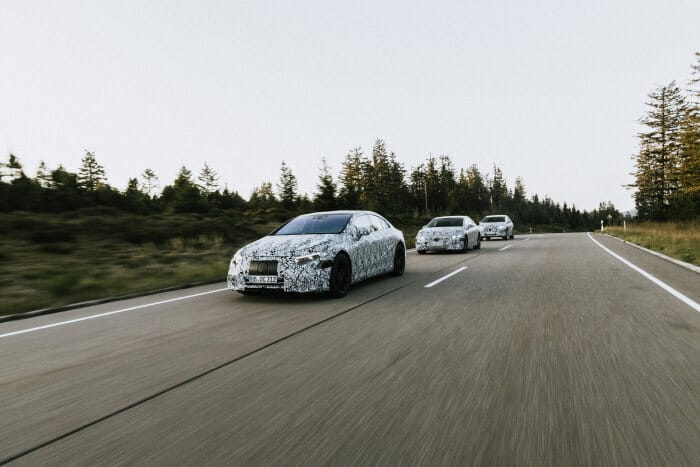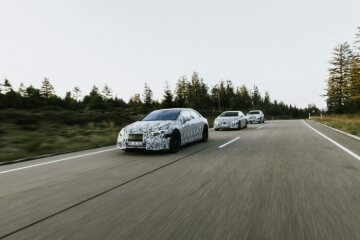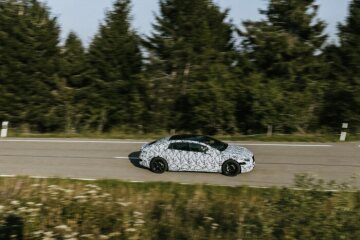
13.
October 2020
Stuttgart
Stuttgart. Even compared with other electric cars, the EQC 400 4MATIC (combined power consumption: 21.3-20.2 kWh/100 km; combined CO2 emissions: 0 g/km)[1] is extremely quiet in the interior. Thus the ideal demonstration vehicle for a technology of tomorrow: Future Mercedes-Benz EQ model generations will become a multi-sensory experience with selectable soundscapes and intuitively understood feedback sounds. The software for this future vision is created in-house.
No V8 rumble, no diesel knock, no turbo slurp – electric cars are quiet by nature. Nonetheless, driving in future Mercedes-Benz EQ model generations will optionally become a multi-sensory experience: the sound experts of Mercedes-Benz are working on making the paradigm shift from combustion model to electric car audible as well.
The listening test in a demo EQC shows what developments they are currently working on: different soundscapes enable an individual acoustic set-up here. The soundscapes can be selected and also switched off via a menu in MBUX on the central display. Over-the-air updates are conceivable in future.
Also part of the particular soundscape is the driving sound, which is reproduced by the speakers in the interior. It awakens emotions and inspires. At the same time the driving sound is interactive, as it responds to a good dozen parameters such as the accelerator position, speed or recuperation. Selection of the drive program likewise influences the driving sound, for example, the sounds become more dynamic in SPORT mode. The technology uses intelligent sound design algorithms to calculate the sounds coming from the amplifier of the Burmester® surround sound system in real time and the loudspeakers to reproduce them.
The holistic sound concept also includes sounds that give the driver feedback – for example, when the car is unlocked, when it can be started or even as a farewell. Connecting the charging plug also is accompanied by acoustic feedback that is intuitive to understand, this time outside the vehicle. For example, the driver can be given an acoustic signal that the charging procedure was successful, and indicating the charge state of the battery.
To reproduce this feedback outside the vehicle, Mercedes-Benz uses the loudspeakers of the Acoustic Vehicle Alert System (AVAS) in the bumpers. This system is mandatory for new electric cars type-approved (homologised) since 1 July 2019. In Europe AVAS must be operational up to a speed of 20 km/h. When driving slowly, it generates an external sound so that pedestrians are aware of the electric car's approach.
The algorithms and sounds for the sound design are created in-house at Mercedes-Benz. In addition to physicists, the interdisciplinary team also includes sound designers, media designers and mechatronics specialists. They work on the emotionalising sound of future Mercedes-Benz EQ models in an acoustic laboratory which is shielded from external noises and vibrations. And they conduct listening tests during test drives of interactive demo vehicles, including at the new Immendingen Test and Technology Centre (TTC).
To achieve a really empathetic relationship between the interaction of the driver and the sound feedback, their work is not just based on musical compositions and harmonies, but also on varying the vibrancy of the soundscape with numerous sound dimensions. This elevates the sound design to a holistic multi-sensory experience that interacts with the whole vehicle. This experience is the contrast between comfortably quiet and precise feedback with emotionally appealing design.
Here are some facts and figures:
- Over 120 in-house test subjects from administrators to top management conducted test drives of the demo vehicle and contributed their impressions to the design process.
- Many different sound variants and compositions were tried and evolved during the development phase. The roots of some sounds date back more than 10 years.
- Humans can hear in the frequency range from 20 Hz to 20 kHz, which is also used for the sound production – though naturally as a harmonious, orchestral composition
- The sound algorithms push a normal laptop to its performance limits, the digital signal processor (DSP) uses about 1 GHz of computing power
- 250 engineers work on making the car more comfortable and quiet, while about 10 engineers and sound designers attend to sound quality.
[1] The power consumption was determined on the basis of Directive 692/2008/EC. The power consumption is dependent upon the vehicle configuration. Further information on the official fuel consumption and the official specific CO2 emissions of new passenger cars can be found in the "Leitfaden über den Kraftstoffverbrauch, die CO2-Emissionen und den Stromverbrauch neuer Personenkraftwagen" [Guide to fuel consumption, CO₂ emissions and power consumption of new passenger cars], which is available free of charge at all sales outlets and from Deutsche Automobil Treuhand GmbH at www.dat.de.
Press Contact
- Manager Global Product Communications EQ & AV Communications
- wolfgang.wuerth@daimler.com
- Tel: +49 160 8620345
- Head of Global Product and Technology Communications
- koert.groeneveld@daimler.com
- Tel: +49 160 8614747
Press Contact Overview
Media
Download
Filter
Show thumbnails
Show list
Slideshow
Settings
- Preview

Do you really want to delete the data record?
Please wait a moment …
Please wait a moment …
Please wait a moment …
Please wait a moment …
- 20C0569_073
-
Legend
:Mercedes-Benz EQ testing
-
Release date
:Oct 6, 2020
- 20C0569_095
-
Legend
:Mercedes-Benz EQ testing
-
Release date
:Oct 6, 2020

LoadingOriginal Article




